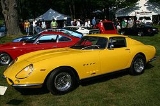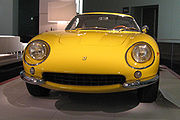
Ferrari 275
Encyclopedia
- See also the 275 F1Ferrari 375 F1After finding only modest success with the supercharged 125 F1 car in Formula One, Ferrari decided to switch for 1950 to the naturally aspirated 4.5 L formula for the series...
, a Formula OneFormula OneFormula One, also known as Formula 1 or F1 and referred to officially as the FIA Formula One World Championship, is the highest class of single seater auto racing sanctioned by the Fédération Internationale de l'Automobile . The "formula" designation in the name refers to a set of rules with which...
racer
The Ferrari 275 was a 2-seat front-engined Gran Turismo
Grand tourer
A grand tourer is a high-performance luxury automobile designed for long-distance driving. The most common format is a two-door coupé with either a two-seat or a 2+2 arrangement....
automobile
Automobile
An automobile, autocar, motor car or car is a wheeled motor vehicle used for transporting passengers, which also carries its own engine or motor...
produced by Ferrari
Ferrari
Ferrari S.p.A. is an Italian sports car manufacturer based in Maranello, Italy. Founded by Enzo Ferrari in 1929, as Scuderia Ferrari, the company sponsored drivers and manufactured race cars before moving into production of street-legal vehicles as Ferrari S.p.A. in 1947...
between 1964 and 1968. It used a 3.3 L (3286 cc) Colombo
Ferrari Colombo engine
Ferrari's earliest cars used engines designed by Gioacchino Colombo, who had formerly designed Alfa Romeos for Enzo Ferrari. These V12 powerplants ranged from the diminutive 1.5 L unit fitted to the 125S to the 3.3 L unit in the 1966 275.Enzo Ferrari had long admired the V12 engines of...
60° V12 engine
V12 engine
A V12 engine is a V engine with 12 cylinders mounted on the crankcase in two banks of six cylinders, usually but not always at a 60° angle to each other, with all 12 pistons driving a common crankshaft....
and produced 280-300 hp. The Pininfarina
Pininfarina
Pininfarina S.p.A. is an Italian car design firm and coachbuilder in Cambiano, Italy.Founded as Società anonima Carrozzeria Pinin Farina in 1930 by automobile designer and builder Battista "Pinin" Farina, Pininfarina has been employed by a wide variety of high-end automobile manufacturers,...
-designed body was a graceful evolution of the car's predecessor, the 250
Ferrari 250
The Ferrari 250 is a sports car built by Ferrari from 1953 to 1964. The company's most successful early line, the 250 series included several variants. It was replaced by the 275 and the 330.-Similarities:...
, and strongly contrasted with its replacement, the Daytona
Ferrari Daytona
The Ferrari 365 GTB/4, better known by the unofficial name Ferrari Daytona, is a Gran Turismo automobile produced from 1968 to 1973. It was first introduced to the public at the Paris Auto Salon in 1968 and replaced the 275 GTB/4...
. The 275 introduced Ferrari's "transaxle
Transaxle
In the automotive field, a transaxle is a major mechanical component that combines the functionality of the transmission, the differential, and associated components of the driven axle into one integrated assembly....
" concept, where the transmission and rear axle are integrated.
Motor Trend Classic
Motor Trend
Motor Trend is an American automobile magazine. It first appeared in September 1949, issued by Petersen Publishing Company in Los Angeles, and bearing the tag line "The Magazine for a Motoring World". Petersen Publishing was sold to British publisher EMAP in 1998, who sold the former Petersen...
named the 275 GTB/GTS as number three in their list of the ten "Greatest Ferraris of all time".
275 GTB
The standard 275 GTB coupe was produced by Scaglietti and was available with 3 or 6 Weber twin-choke carburettors. It was more of a pure sports car than the GT name suggested. Some cars were built with an aluminium body instead of the standard steel body. A Series Two version with a longer nose appeared in 1965.275 GTS
Pininfarina built 200 275 GTS RoadsterRoadster
A roadster is a two-seat open car with emphasis on sporty handling and without a fixed roof or side weather protection. Strictly speaking a roadster with wind-up windows is a convertible but as true roadsters are no longer made the distinction is now irrelevant...
s for the American market (including 14 in right hand drive) between 1964-1966 with entirely different bodywork. It was intended to be more of a GT car and less of a sports car than its GTB brother. The 275 GTS was replaced by the 330 GTS with the switch to the four-cam engine, leaving no 3.3 L convertible in the range until the creation of the 275 GTB/4 NART Spider.
The 330 engine was a two cam engine. not a 4 cam
.jpg)
275 GTB/C
For the 1965 racing season, 4 lightweight 275 GTB Competizione Speciales were built and equipped with 250 LM engines.For the 1966 season, Ferrari decided to build 12 lightweight 275 GTB/C cars, they were constructed between the end of the 275 two-cam production run and the start of the 275 four-cam production run; even though they very much resembled the road-going 275 GTB, not one body panel was the same and underneath and very little of the road car remained.
Mauro Forghieri designed a special super-lightweight steel and aluminium version of the 275 GTB chassis. A regular suspension was fitted, but it was made slightly stiffer by the addition of extra springs. Scaglietti bodied the chassis with an ultra thin aluminum body; the panels were about half as thick as the ones used on the GTO and the Cobra - even leaning on the 275 GTB/C would dent the body; the entire rear section was reinforced by fiberglass to prevent it from flexing at the slightest impact. In all, this focus on saving weight made a difference of over 150 kg (331 lb) compared to the alloy bodied road cars.
Like the four 'Competizione Speciales', the 275 GTB/C was powered by the 250 LM engine. Somehow Ferrari 'forgot' to mention to the governing body that the 275 GTB had a six carburetor option, so only a three 'carb' engine could be homologated. Specifically for the 275 GTB/C, Weber constructed the 40 DF13 carburetor of which three would replace the six 38 DCNs found on the 250 LM. The rest of the drivetrain was similar to the 275 GTB, but strengthened slightly.
Two of the twelve built were sold for street use. Unlike the race cars, these street cars were fitted with alloy wheels shod with Pirelli tires. Competition cars were fitted with special Borrani wire wheels, shod with Dunlop's latest racing tires. It was this combination that would prove to be the weak spot of the 275 GTB/C; the tires had so much grip that they could overstress and break the spokes on the wheels. After the 275 GTB/C, no competition Ferrari would be fitted with wire wheels again.
A British-entered 275 GTB/C finished 8th overall, gaining class victory in the 1966 24 Hours of Le Mans
1966 24 Hours of Le Mans
The 1966 24 Hours of Le Mans was the 34th Grand Prix of Endurance, and took place on June 18 and 19 1966. It was also the seventh round of the World Sportscar Championship.-Pre-race:...
.
Four-cam



275 GTB/4
Introduced at the Paris Motor Show in October 1966, the 275 GTB/4 (or 4-cam) was a substantially updated car; built by Scaglietti, it featured new bodywork and was the first Ferrari to not be offered with wire wheels.Power came from a substantially reworked Colombo
Ferrari Colombo engine
Ferrari's earliest cars used engines designed by Gioacchino Colombo, who had formerly designed Alfa Romeos for Enzo Ferrari. These V12 powerplants ranged from the diminutive 1.5 L unit fitted to the 125S to the 3.3 L unit in the 1966 275.Enzo Ferrari had long admired the V12 engines of...
V12
V12 engine
A V12 engine is a V engine with 12 cylinders mounted on the crankcase in two banks of six cylinders, usually but not always at a 60° angle to each other, with all 12 pistons driving a common crankshaft....
, still with two valves per cylinder but now with a four-cam engine and six carburettors as standard. In a departure from previous Ferrari designs, the valve angle was reduced three degrees to 54° for a more-compact head. The dual camshafts also allowed the valves to be aligned "correctly" (perpendicular to the camshaft) instead of offset as in the SOHC Ferraris. It was a dry-sump design with a huge 17 qt (16 L) capacity. The individual cylinder capacity remained unchanged at slightly under 275cc, which as before gave the model the first three digits of its name, and when multiplied by the number of cylinders equals 3,286cc total swept volume.
The transaxle was also redesigned. A torque tube connected the engine and transmission, rather than allowing them to float free on the body as before. This improved handling, noise, and vibration. Porsche
Porsche
Porsche Automobil Holding SE, usually shortened to Porsche SE a Societas Europaea or European Public Company, is a German based holding company with investments in the automotive industry....
synchronizers were also fitted for improved shifting and reliability.
The 275 GTB/4 could hit 165 mi/h with its 300 hp. 280 4-cam versions were produced through 1968.
In 2004, Sports Car International
Sports Car International
Sports Car International was an automobile magazine in the United States published by Ross Periodicals Inc. that was focused on sports cars. The magazine was published from 1986 to 2008. Its business offices were located in Novato, California....
named the 275 GTB/4 number seven on the list of Top Sports Cars of the 1960s.
275 GTB/4 NART
A 275 GTB/4 N.A.R.T. Spyder version was only available from a single American dealer, Luigi ChinettiLuigi Chinetti
Luigi Chinetti was an Italian-born racecar driver, who emigrated to the United States during World War II and became an American citizen....
, who was not satisfied with the 275 GTB/4. He asked Sergio Scaglietti and Enzo Ferrari
Enzo Ferrari
Enzo Anselmo Ferrari Cavaliere di Gran Croce OMRI was an Italian race car driver and entrepreneur, the founder of the Scuderia Ferrari Grand Prix motor racing team, and subsequently of the Ferrari car manufacturer...
to build a few Spyder versions of the 275 GTB/4, which he bought for approximately $8,000 each; N.A.R.T. stood for Chinetti's North American Racing Team
North American Racing Team
The North American Racing Team was created by Luigi Chinetti to promote the Ferrari marque in America through success in Gran Turismo motorsport....
. In a contemporary road test, Road & Track
Road & Track
Road & Track is an American automotive enthusiast magazine. It is owned by Hearst Magazines, and is published monthly. The editorial offices are located in Newport Beach, California.-History:...
commended the Spyder as "the most satisfying sports car in the world."
It was to be a custom run of 25 cars straight from Scaglietti, but just 10 were built in 1967 and 1968, making this one of the most valuable Ferraris. Chassis number 09437 fetched $3.96m at auction in August 2005. The ten NART Spiders used chassis numbers 09437, 09751, 10139, 10219, 10249, 10453, 10691, 10709, 10749, and 11057. In the 1968 movie "The Thomas Crown Affair" the Ferrari driven by Faye Dunaway and being referred to as "one of those red Italian things" is actually the first of only ten Ferrari 275 GTS Spyder NART, serial number 09437. This particular car came second in its class in the 1968 12 hour of Sebring before being repainted and used for the movie. Steve McQueen liked the car so much, he wanted one for himself. He eventually ended up with serial number 10453. That car is today with collector Anthony Wang in NY, USA.

